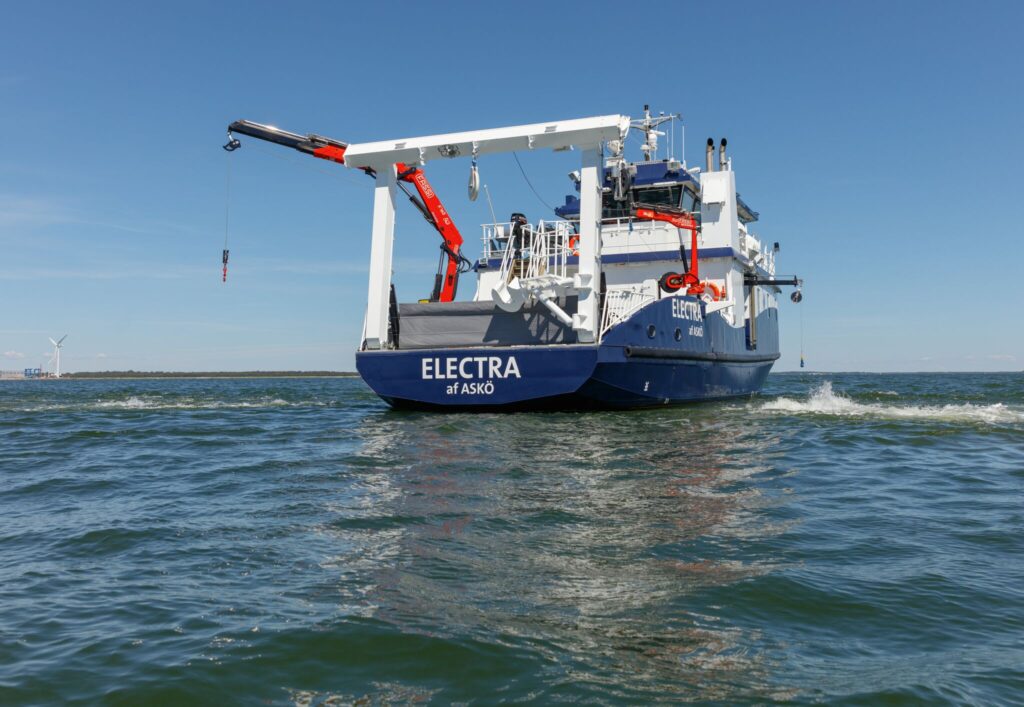
Baltic Workboats has delivered a scientific research vessel Electra to Stockholm University of Sweden. The vessel is designated mainly for research work on the Baltic Sea and transport of students from the mainland to Askö island research center. The Vessel is built and equipped so that it can accommodate up to 35 passengers plus crew. Hull has been constructed of steel and built according to LRS “+100A1 SSC Workboat, Mono, G3, Ice class 1 C FS MCH UMS” and Finnish-Swedish ice class 1C rules under the inspection of STA.
For staying on board the vessel is built with two single and two double cabins for crew under the main deck. Sound insulation onboard meets highest demands by not exceeding 55 dB(A) anywhere in the accommodation or work space during sailing.
Vessel is densely loaded with various research equipment – Set of Kongsberg sensors integrated into vessel hull, Topas PS40, EK80 and EM2040 together with Mini SVS, Mini SVP and ADCP sensors all connected into K-sync system and with possibility to display and control all data on any of the 17 screens onboard the vessel through the KVM system. Sensors allow monitoring and saving information about in-water life, seabed around the vessel and “penetrate” up to 50m within the sediment layers in the sea bottom.
In addition, the vessel will be supplied with 4 research winches for all kinds of sampling including 12-metre piston corer for bottom sediment samples. These operations are supported by 3 cranes and an A-frame. Special attention is paid to a custom-made 10hp electrical winch, which is located in the wet lab and can be set to operation through side door. This winch has custom integration with Kongsberg MRU system to detect any kind of vessel movement and to compensate winch wire length accordingly to keep the water samples taken with Seabird 911 within a couple of centimeters of desired depth even at stormy seas.
Electra is powered by twin heavy duty Volvo Penta D16MH marine diesel engines with an output of 368 kW @ 1800 rpm, each powering Rolls-Royce US105 FP azimuth thrusters via cardan shafts. The whole propulsion plant is built to match the Finnish-Swedish ice class 1C rules.
To grant steady working environment for the scientists onboard there are two Seakeeper 35HD gyrostabilizers that have been calculated to reduce roll by 80% at up to 2m waves. To prevent vessel movement due to wind or current it has Navis Engineering DP system with five operating positions all around the vessel to make scientific research with maximum precision. The bridge has two main operating positions, providing all navigational operations can be performed either on the bow side or aft side of the wheelhouse.
Vessel Specifications:
Length Overall – 24,3 m
Beam – 7,2 m
Draft – 2,1 m
Displacement – 160 tons
Engine – 2 x Volvo Penta D16 MH R1
Power – 2 x 368 kW @ 1800 rpm
Propulsion Rolls-Royce azimuth thrusters US105FP
Cranes – Fassi F165, Fassi M25, Fassi M10
Passengers – max 35
Range – 260 nm
Speed – 11 knots
Classification – Built under STA supervision according to LRS “+100A1 SSC Workboat, Mono, G3, Ice Class 1 C FS MCH UMS” and Finnish-Swedish 1C ice class rules
